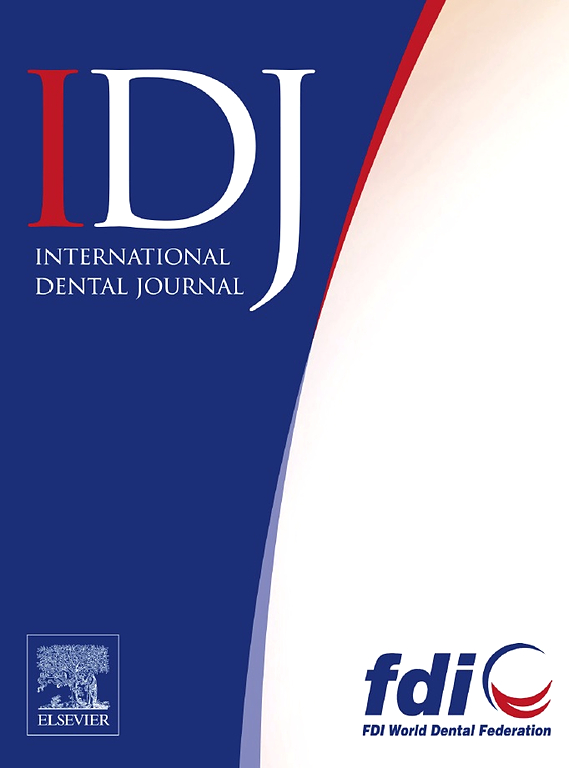比较糖尿病和非糖尿病牙周炎患者的根管治疗患病率:回顾性病例-对照调查
IF 3.2
3区 医学
Q1 DENTISTRY, ORAL SURGERY & MEDICINE
引用次数: 0
摘要
目的通过病例对照回顾性分析,探讨糖尿病(DM)患者与非糖尿病(NDM)患者进行牙髓治疗后牙齿的患病率可能存在的差异。方法将诊断为牙周炎并转诊到牙周治疗专科诊所的糖尿病和非糖尿病成人按年龄、性别和就诊年份进行匹配。为了评估根管治疗的牙齿数量,需要一套全口x线片。记录每一颗补根牙齿。根据牙齿类型及其在上下颌的位置进行亚分析以评估牙齿的分布。此外,还统计了牙齿的数量。分析根管治疗后牙齿与相关变量的关系。结果共有233例糖尿病牙周炎患者符合纳入条件,并与233例非糖尿病牙周炎患者相匹配。糖尿病与非糖尿病牙周炎患者接受根管治疗的平均百分比差异无统计学意义(DM: 6.88%;的NDM: 7.34%;P = 0.60)、牙型或颌型与平均牙数无关(DM: 25.2;的NDM: 25.3;P = .68)。根据年龄、吸烟状况和牙齿数量校正后的多因素分析,糖尿病与接受根管治疗的牙齿数量无显著相关(OR = 1.16;95% CI: [0.79;1.70];P = .46)。结论在成人牙周炎患者的匹配样本中,与非牙周炎患者相比,糖尿病的出现与根管治疗的牙齿数量或牙齿脱落没有显著相关性。这表明,在牙周炎患者中,糖尿病似乎不是影响蛀牙程度的危险因素,需要进行牙髓治疗,在这种情况下,糖尿病似乎也不会增加牙齿脱落的可能性。本文章由计算机程序翻译,如有差异,请以英文原文为准。
Comparing Endodontic Treatment Prevalence in Diabetes Mellitus and Non-Diabetic Periodontitis Patients: A Retrospective Case-Control Investigation
Objective
Apply a case-control retrospective analysis to assess possible differences in the prevalence of endodontically treated teeth in patients with diabetes(DM) and non-diabetics(NDM).
Methods
A convenience sample of DM and NDM adults diagnosed with periodontitis and referred to a clinic specializing in periodontal therapy were matched based on age, gender, and year of intake. To assess the number of endodontically treated teeth, a full-mouth set of radiographs was required. Every root-filled tooth was recorded. Sub-analyses were conducted to assess the distribution of teeth based on tooth type and their location in the upper and lower jaws. Additionally, the number of teeth present was counted. Relationships between endodontically treated teeth and related variables were analysed.
Results
Total 233 periodontitis patients with DM were found to be eligible for inclusion and accordingly matched to 233 periodontitis patients without DM. Between DM and NDM, no statistically significant differences were found in the mean percentage of endodontically treated teeth (DM: 6.88%; NDM: 7.34%; P = .60), tooth type, or jaw type, nor in the average number of teeth (DM: 25.2; NDM: 25.3; P = .68). Based on the multivariate analyses with correction for age, smoking status, and number of teeth, DM was not significantly associated with the number of endodontically treated teeth (OR = 1.16;95% CI: [0.79;1.70]; P = .46).
Conclusion
In matched patient sample with adult periodontitis, there was no significant association between DM appearance and the number of endodontically treated teeth or tooth loss when compared with NDM.
Clinical relevance
This suggests that in periodontitis patients DM appears not to be a risk factor influencing the degree of tooth decay necessitating endodontic intervention, nor does it seem to contribute to an increased likelihood of tooth loss in this context.
求助全文
通过发布文献求助,成功后即可免费获取论文全文。
去求助
来源期刊

International dental journal
医学-牙科与口腔外科
CiteScore
4.80
自引率
6.10%
发文量
159
审稿时长
63 days
期刊介绍:
The International Dental Journal features peer-reviewed, scientific articles relevant to international oral health issues, as well as practical, informative articles aimed at clinicians.
 求助内容:
求助内容: 应助结果提醒方式:
应助结果提醒方式:


